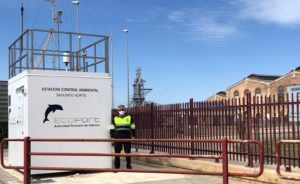
The Sagunto cabin joins the two stations located in the Port of Valencia, in front of the Cabanyal and Natzaret neighbourhoods
The Valenciaport booths record 8 elements of different gases and particles to analyse air quality, compared to other facilities that only collect particles and meteorological data
The data can be checked on the Valenciaport website or on the website of the Regional Ministry of Agriculture, Rural Development, Climate Emergency and Ecological Transition
The Port Authority of Valencia was the first Spanish port and the second in Europe to achieve EMAS registration, the most demanding certificate in terms of environmental management and auditing
From 2008 to 2019, the carbon footprint of the Port of Valencia has been reduced by 30% while activity has grown by 42%
València, May 19th, 2021.- The Port Authority of Valencia (PAV) has installed in the Port of Sagunto what is already its third environmental control and air quality measurement cabin, which will enable the levels of concentration in port activity to be measured and its scope in urban centres to be monitored. This initiative will provide analyses and parameters with useful information for the port community and for the residents of the port neighbourhoods.
The installation is in addition to the two cabins located in the Port of València, specifically on the esplanade of the old Turia riverbed – in front of the Natzaret neighbourhood – and on the “Transversales of Poniente” quay – in front of the Cabanyal neighbourhood.
These PAV cabins carry the Ecoport badge and are equipped with the latest technology for measuring and controlling atmospheric pollutants. They have five gas analysers that measure the concentration of sulphur dioxide (SO2), nitrogen oxides (NO2/NO/NOx), ozone (O3), carbon monoxide (CO) and PM10 and PM2.5 particles. They also have a meteorological station, for observation and recording of wind speed and direction, rainfall, solar radiation, temperature, relative humidity and barometric pressure; and are endorsed and installed according to the technicians of the Centre for Environmental Studies for the Mediterranean (CEAM). They also include sound level meters to measure the port’s acoustic levels. All this data is received in real time, which allows the establishment of indicators to control both air quality and noise.
Thus, the Valenciaport installations contemplate pollutant gas and particle parameters (it collects 8 different elements) and meteorological indicators (another 8 sources of data), as opposed to other cabins which only contemplate the measurement of PM10 and PM2.5 particles.
The two cabins in the Port of València are part of the GREEN C PORTS project – with a budget of more than 300,000 euros – which is coordinated by the Valenciaport Foundation and co-financed by the European Union. These actions highlight the efforts to carry out environmental actions for the sake of a commitment and behaviour towards decarbonisation and transparency.
Checking the data
On the Valenciaport website, the air quality of the environmental control cabin located on the esplanade of the old Turia riverbed can now be checked in real time. This cabin, which is connected to the Generalitat Valenciana’s monitoring network of the Regional Ministry of Agriculture, Rural Development, Climate Emergency and Ecological Transition, showed good to excellent air quality in April.
In addition to these three cabins, Valenciaport has also installed seven new environmental sensors to complement the current equipment. The aim of the Port Authority of Valencia (PAV) is to reinforce its commitment to sustainability by means of innovative solutions which enable aspects such as air quality to be analysed and to offer information to the port community and the Port’s neighbours in an active and regular manner.

Commitment to the environment
The PAV complies with all international environmental quality standards, including the EMAS regulation, the most demanding certificate in terms of environmental management and auditing. In fact, Valenciaport was the first Spanish port and the second European port to achieve this accreditation in 2008 and is the only port in the Valencia Region to be registered in the EMAS register of the Regional Ministry of Agriculture.
In addition, the PAV was the first port authority in Spain to register the Carbon Footprint of a port in the Carbon Footprint register created by the Ministry of Ecological Transition, obtaining the “Calculo” seal. In addition, València is also a pioneering port in the world in measuring its Carbon Footprint under the ISO 14064-1:2012 standard, a methodology that includes measurement at four levels: emissions from electricity and fuel consumption of the PAV, concessionary companies, ships and land transport produced within the port area of València.
From 2008 to 2019, the carbon footprint of the Port of València has been reduced by 30%, from 3.19 to 2.23 kg of CO2 per tonne handled. In the same period, the activity of Valenciaport grew by 42%, from 52 million tonnes handled in 2008 to 74 million tonnes at the close of the 2019 financial year. These figures position Valenciaport as an international benchmark in port developments and strategies for decarbonisation by showing with concrete facts and figures that the growth of economic activity is not at odds with the reduction of CO2.
The Port of València also holds the PERS certification; the only environmental management standard specific to the port sector and incorporates, in addition to the main general requirements of the recognised standards (such as ISO 14001), the port specifications based on the ESPO recommendations, which are audited by an independent firm of recognised international prestige such as Lloyd’s Register.
Valenciaport is part of the “EcoPorts” network of ports, which is the main environmental initiative of the European port sector and whose aim is to improve environmental management and raise awareness of environmental protection through cooperation and exchange of knowledge between the different ports.

